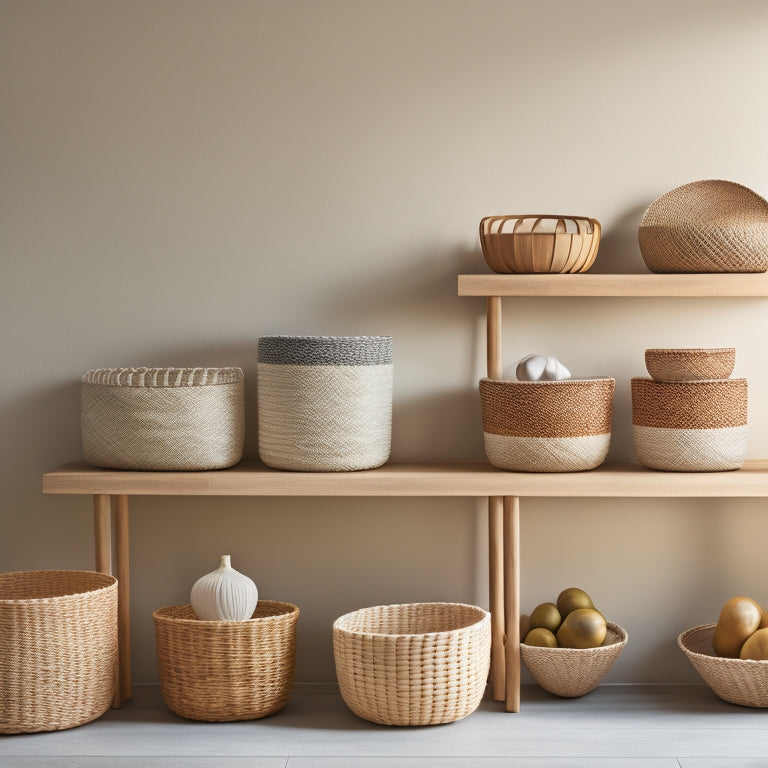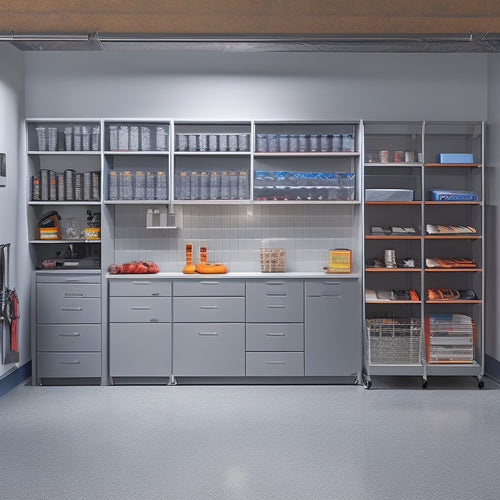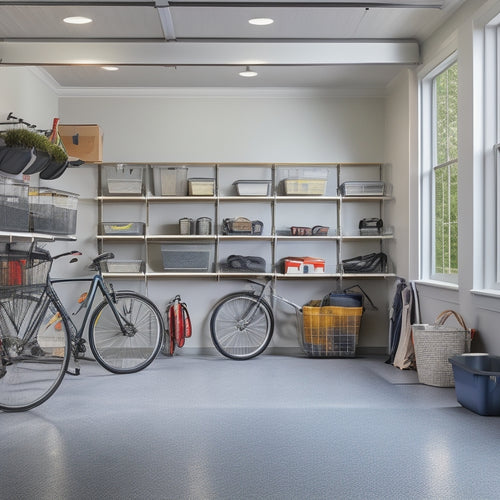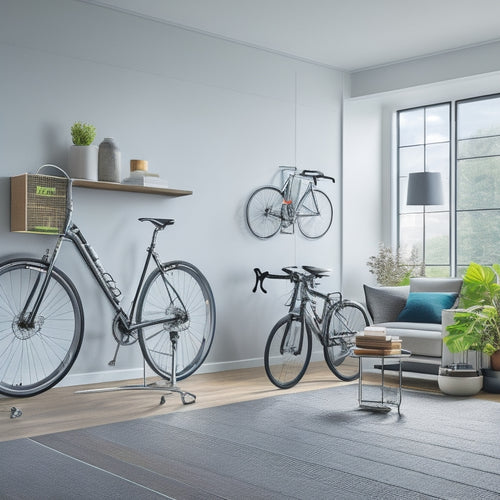
Organizing Baskets on Shelves for a Clutter-Free Space
Share
To create a clutter-free space, start by choosing the right baskets that fit your shelf dimensions and item sizes, considering materials, durability, and accessibility. Measure your shelves accurately to guarantee a perfect fit. Pick a storage theme that ties everything together, and group similar items into categories for easy access. Label your baskets for quick identification, and implement an easy identification system using color coding and clear labels. By maximizing your vertical storage space and maintaining your organized shelves, you'll be well on your way to a serene oasis - and with a few more tweaks, you'll be able to keep it that way.
Key Takeaways
- Choose baskets that match the aesthetic and are easy to clean, considering materials like wicker, plastic, or metal for durability and functionality.
- Measure shelves accurately to select baskets that fit perfectly, allowing for easy retrieval of contents and avoiding clutter or wasted space.
- Select a storage theme that ties everything together, incorporating decorative accents and personal style while meeting storage needs.
- Label baskets clearly and consistently, using color coding, images, or icons for quick identification and categorizing items by type or frequency of use.
- Maximize vertical storage space by stacking baskets, using vertical dividers, and installing organizational tools like shelf liners or adhesive hooks.
Choosing the Right Baskets
When it comes to organizing baskets on shelves, the first step is selecting the right ones for the job. You'll want to take into account basket materials that fit your space's aesthetic and are easy to clean. For instance, wicker baskets are perfect for a rustic look, while plastic baskets are ideal for a modern feel.
Next, think about the basket sizes you need. Measure the items you plan to store and choose baskets that can comfortably hold them. You don't want baskets that are too small or too large, as they can look cluttered or wasted space.
Basket colors, shapes, and textures are also essential. You can choose baskets that match your shelf's color scheme or contrast them for visual appeal. Take into account rounded baskets for soft items like clothes or rectangular ones for books and files.
Lastly, evaluate basket styles, durability, and accessibility. Do you prefer open-weave baskets or solid ones? Are the baskets easy to lift and carry? Are they sturdy enough to hold the weight of your items?
Measuring Your Shelves Correctly
Across from your newly selected baskets, your shelves await, ready to be measured correctly to confirm a perfect fit. To guarantee a seamless installation, you'll need to take precise shelf dimensions. Gather your measuring tools, including a tape measure, ruler, or caliper, and get started.
| Shelf Dimension | Measuring Tool |
|---|---|
| Width | Tape measure or ruler |
| Depth | Tape measure or ruler |
| Height | Tape measure or caliper |
Measure the width, depth, and height of each shelf, taking note of any obstructions or irregularities. Record these measurements accurately to reference later. Double-check your measurements to avoid errors, as even a slight miscalculation can affect the fit of your baskets. By taking the time to measure your shelves correctly, you'll be able to choose baskets that fit perfectly, confirming a clutter-free space that's both functional and visually appealing.
Picking a Storage Theme
With your shelf dimensions in hand, it's time to contemplate the overall aesthetic and functionality you want to achieve with your organized storage system.
You'll want to evaluate a storage theme that ties everything together. Think about the color schemes you'll use - will they be bright and bold or soft and calming?
Material choices are also important, as they can add texture and depth to your shelves. Decorative accents, like ribbons or labels, can add a personal touch.
Examine functional styles, like woven baskets or clear containers, that make it easy to see what's inside. If you like to decorate for the seasons, think about incorporating seasonal themes into your storage system.
A minimalist approach can create a calm and peaceful space, while playful designs can add some fun and whimsy.
Whatever theme you choose, make sure it reflects your personal style and meets your storage needs.
Grouping Similar Items Together
You'll want to categorize your items by type, so all similar items are together, making it easy to find what you need.
You should also consider storing items by frequency of use, keeping the most-used items front and center.
Categorize By Item Type
Several types of items often clutter shelves, making it essential to categorize them by type to maintain a sense of organization. This approach allows you to group similar items together, creating a sense of order and making it easier to find what you need. By categorizing items by type, you can:
| Item Type | Examples |
| Toys | Stuffed animals, building blocks, puzzles |
| Books | Novels, cookbooks, self-help books |
| Office Supplies | Pens, paper, folders, stapler |
| Kitchen Items | Plates, cups, utensils, appliances |
| Decorations | Vases, images, candles, ornaments |
When categorizing items, consider the purpose or function of each item. For instance, if you have a collection of kitchen items, group them together in a designated area. This organization strategy helps you visualize what you have, making it easier to identify what's missing or what you can get rid of. By categorizing items by type, you'll create a more structured and peaceful space that promotes safety and reduces stress.
Store By Frequency Use
Now that you've categorized your items by type, it's time to take organization a step further by storing them by frequency of use. This means placing the items you use daily in easy-to-reach locations and storing less frequently used items towards the back or on higher shelves.
Consider the following when storing by frequency of use:
-
Daily essentials: Store toiletries, cleaning supplies, and other daily essentials in baskets on shelves that are easily accessible.
-
Seasonal items: Designate specific baskets for seasonal storage, such as winter clothing or holiday decorations, to keep them out of the way but still organized.
-
Frequently used books: Store your favorite books or most frequently read books in a basket on a shelf near your reading nook.
-
Kitchen utensils: Organize kitchen utensils, like pots and pans, by frequency of use to make cooking and meal prep more efficient.
-
Less frequent items: Store items you use less frequently, like special occasion dishes or out-of-season clothing, in baskets on higher shelves or in harder-to-reach areas.
Purge Unused Items
As you're arranging your baskets on shelves, it's essential to remember that organization isn't just about storing items, but also about letting go of what's no longer needed.
Purging unused items is a fundamental step in achieving a clutter-free space. Start by grouping similar items together, making it easier to identify what you no longer need or use. Be honest with yourself – if you haven't used it in the past year, it's likely you won't miss it.
Effective decluttering strategies involve being ruthless about what's taking up important space in your home. Set up a "donate" and "recycle" box to sort items into.
Consider item donation or repurposing items that are still in good condition. This not only declutters your space but also benefits others.
Labeling Baskets for Easy Access
You'll want to create a labeling system that helps you quickly identify what's inside each basket.
You can start by assigning category labels to each basket, such as "crafting supplies" or "office materials".
Next, consider creating a list of the specific contents of each basket, so you can easily find what you need without having to dig through everything.
Category Labels
Labeling your baskets with category labels is an essential step in maintaining an organized system on your shelves. This helps you quickly identify what's inside each basket, making it easier to find what you need and preventing clutter from building up again.
To create effective category labels, consider the following:
-
Seasonal categories: Label baskets with seasons (e.g., Winter, Spring, Summer, Fall) to store seasonal items like decorations, clothing, or outdoor gear.
-
Color coding: Use different colored labels or stickers to categorize baskets by type, such as red for toys, blue for books, or green for cleaning supplies.
-
Room-specific labels: Label baskets by room, like "Living Room" or "Kitchen," to help you find items quickly and easily.
-
Task-oriented labels: Use labels that describe the task or activity, such as "Crafting" or "Gift Wrapping," to store related items together.
-
Alphabetical labels: Arrange labels in alphabetical order, making it easy to find a specific basket when you need it.
Basket Contents List
Frequently, rummaging through a basket to find a specific item can be frustrating and time-consuming. To avoid this, create a basket contents list to guarantee easy access to what you need.
When deciding on basket material options, consider the items you'll be storing. For example, wicker or fabric baskets are suitable for soft items like toys or linens, while plastic or metal baskets are better for heavier or more fragile items.
Basket size considerations are also important. Choose baskets that fit the shelf space and the items you're storing. Labeling the baskets based on their contents helps you quickly identify what's inside, saving you time and effort.
You can write the contents list directly on the basket or attach a small label. Be specific and concise when listing the contents, so you can easily find what you need. For instance, instead of labeling a basket as "office supplies," write "paper clips, stapler, scissors." This way, you'll know exactly what's inside without having to dig through the basket.
Easy Identification System
Many baskets on your shelves can benefit from a clear identification system, making it easy to find what you need at a glance. This is especially important when you're in a hurry or need to access specific items quickly.
A well-designed identification system can save you time and reduce frustration.
To create an effective identification system, consider the following strategies:
- Use color coding to differentiate between categories of items, such as toys, linens, or office supplies.
- Implement shape variation by using baskets of different shapes or sizes to distinguish between contents.
- Add labels or signs to each basket, clearly stating what's inside.
- Use images or icons to help visual learners or young children quickly identify the contents.
- Consider using a consistent font or label style throughout your shelving system to create a cohesive look.
Maximizing Vertical Storage Space
Your shelf is a cache of storage potential, just waiting to be tapped. To maximize vertical storage space, consider the shelf height and choose basket sizes that fit snugly, leaving minimal gaps.
Install vertical dividers to separate baskets and create distinct storage zones. This shelf arrangement allows for easy storage accessibility and prevents clutter from building up.
When selecting baskets, opt for decorative ones that complement your shelf aesthetics. Stacking techniques are essential to space efficiency; place heavier baskets at the bottom and lighter ones on top.
Use organizational tools like shelf liners or adhesive hooks to keep baskets in place and prevent them from toppling over.
Maintaining Your Organized Shelves
From the get-go, set a routine to maintain your organized shelves, making sure they continue to serve you efficiently. This will prevent clutter from building up again and keep your space organized and safe.
To maintain your organized shelves, follow these shelf maintenance tips:
-
Set a reminder to declutter your shelves every 3-6 months to get rid of items you no longer need or use.
-
Assign a home for each item, so everything has a designated place to go back to.
-
Implement the "one in, one out" rule to prevent clutter from accumulating.
-
Dust and clean your shelves regularly to prevent dirt and dust from building up.
-
Consider implementing a "shelf check" into your daily routine, where you quickly glance over your shelves to make certain everything is in its place.
Frequently Asked Questions
Can I Use Wicker Baskets With Metal Shelves?
You can definitely use wicker baskets with metal shelves, but make certain the basket style you choose complements the metal shelf option; for example, a rustic wicker basket pairs well with a distressed metal shelf for a cohesive look.
How Do I Prevent Baskets From Sliding off Shelves?
You secure baskets on shelves by using non-slip mats, adhesive strips, or shelf liner to prevent sliding, and you guarantee a snug fit by choosing the right basket size for the shelf, thereby maintaining safety.
Are Fabric Baskets Durable Enough for Heavy Items?
When choosing fabric baskets, you'll want to evaluate their weight capacity and compare materials; while sturdy canvas or denim baskets can handle heavier items, lighter fabrics like cotton or linen may not be durable enough for your needs.
Can I Mix and Match Different Basket Sizes on One Shelf?
Imagine an orchestra of storage! You can mix and match different basket sizes on one shelf, just be sure to balance visual appeal with shelf height consideration and cohesive basket color coordination to avoid visual chaos.
How Often Should I Clean and Dust My Storage Baskets?
You should clean and dust your storage baskets every 2-3 months to maintain their condition and prevent dust buildup. Follow basket maintenance tips and cleaning frequency recommendations to keep your space safe and organized.
Conclusion
You've done it! Your shelves are now a haven of organization, with neatly arranged baskets holding all your essentials. But will you be able to maintain this clutter-free oasis, or will it slowly devolve into chaos? By following the steps outlined above, you'll be well on your way to keeping your space organized and peaceful. Remember, a little bit of effort upfront can lead to a lifetime of stress-free living.
Related Posts
-

Building a Garage Storage System With Built-Ins
You're about to build a garage storage system with built-ins that fits your unique needs, starting by evaluating your...
-

Bin Garage Storage Ideas for Maximizing Space
You can greatly maximize your garage's storage space by utilizing vertical space with ceiling storage bins, stacking ...
-

Must-Try Bike Storage Ideas in Small Spaces
You're tired of sacrificing precious living space to store your bike, especially in small homes where every square fo...


